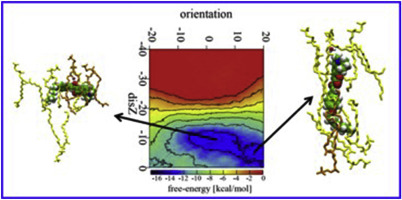Dyes and Pigments ( IF 4.5 ) Pub Date : 2020-03-16 , DOI: 10.1016/j.dyepig.2020.108356 Daniel Zúñiga-Núñez , Francisco Mura , Ricardo A. Zamora , Horacio Poblete , Denis Fuentealba , Alexis Aspée

|
Cinnamoyl coumarin probes acting as fluorescent molecular-rotors were used for evaluating microenvironments in DPPC:DOPC liposomes. For this purpose, derivatization with aliphatic chains between 5 and 12 carbons was used for maximizing interaction with lipid membranes. These probes showed a decrease in the fluorescence intensities and hypsochromic shifts in fluid DOPC and DPPC:DOPC in comparison with DPPC. In particular, for C–CH-5 and C–CH-12, in DPPC:DOPC (1:1) were observed shorter fluorescence lifetimes τ1 associated to the TICT excited state, as well as, an increase on the contribution of the τ3 associated to the ICT excited state, in comparison with other lipid proportions and even pure DPPC and DOPC. Interestingly, all the probes showed one rotational correlation time ϕ1 in DPPC associated with the restricted environment. However, in fluid DOPC and DPPC:DOPC lipid membranes, the long aliphatic chain probes (C–CH-8, 10, and 12) exhibited a faster rotational correlation time ϕ1 than in DPPC and also a larger ϕ2, that indicate the existence of two different environments. The most favorable orientations for C–CH-8 cinnamoyl–coumarin was estimated by employing Molecular Dynamics simulation and an enhanced sampling method. Moreover, the results show two energetic minima corresponding to the most favorable orientations of the probe in the mixture of DPPC:DOPC. These orientations are surrounded by different lipid compositions, which would explain the two rotational correlation times in the lipid mixture.
中文翻译:

在DPPC:DOPC LUV混合物中具有显着荧光分子-转子特性的肉桂酰基-香豆素杂化衍生物
肉桂酰基香豆素探针用作荧光分子转子,用于评估DPPC:DOPC脂质体中的微环境。为此,使用5至12个碳原子之间的脂族链进行衍生化,以最大程度地提高与脂质膜的相互作用。与DPPC相比,这些探针显示了流体DOPC和DPPC:DOPC中的荧光强度和七色移的减少。特别地,对于C-CH-5和C-CH-12,在DPPC:DOPC(1:1)中观察到更短的荧光寿命τ 1关联到TICT兴奋状态,以及,一个上的贡献增加τ 3相关联的信息和通信技术兴奋状态,与其他的脂质比例和甚至纯DPPC DOPC和比较。有趣的是,所有探针都显示出一个旋转相关时间ϕ与受限环境关联的DPPC中为1。但是,在流体DOPC和DPPC:DOPC脂质膜中,长脂肪链探针(C–CH-8、10和12)的旋转相关时间ϕ 1比DPPC快,而correlation 2更大,这表明存在两个不同的环境。通过使用分子动力学模拟和增强的采样方法,估计了C-CH-8肉桂酰基-香豆素的最佳取向。此外,结果显示了两个能量极小值,对应于DPPC:DOPC混合物中探针的最有利方向。这些取向被不同的脂质组成所包围,这将解释脂质混合物中的两个旋转相关时间。


























 京公网安备 11010802027423号
京公网安备 11010802027423号